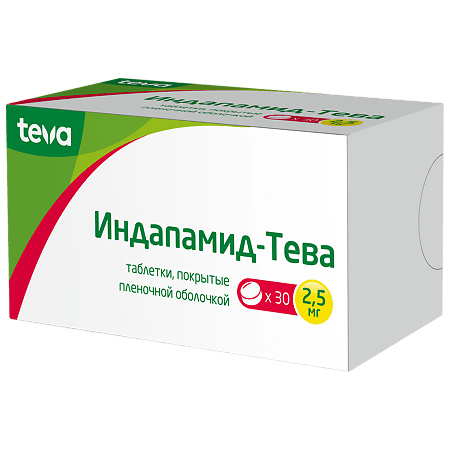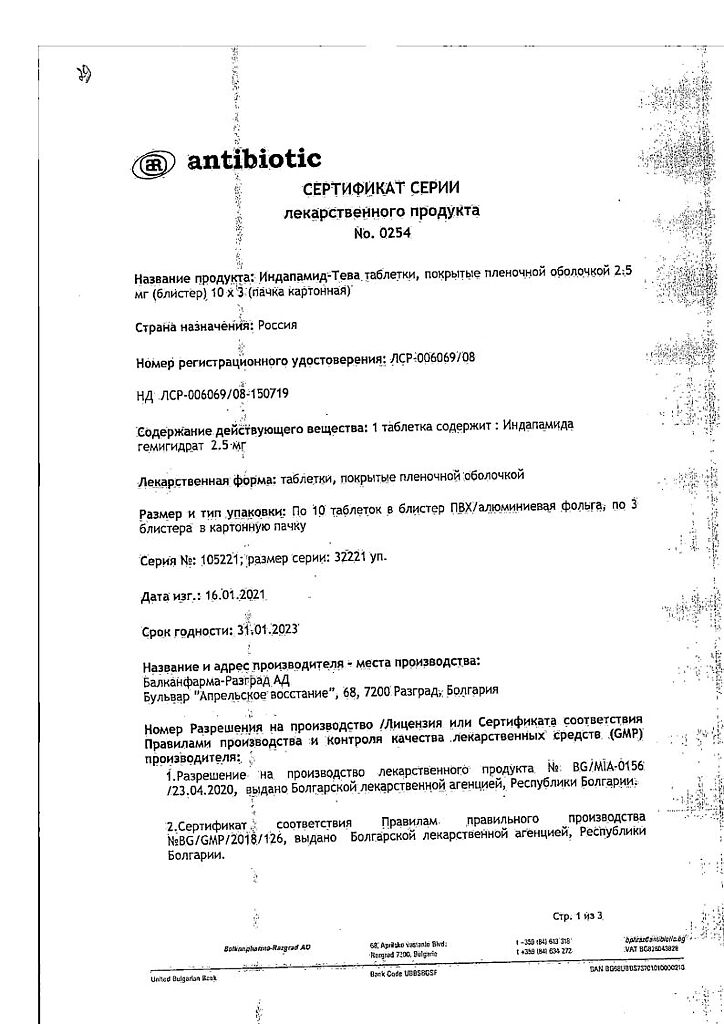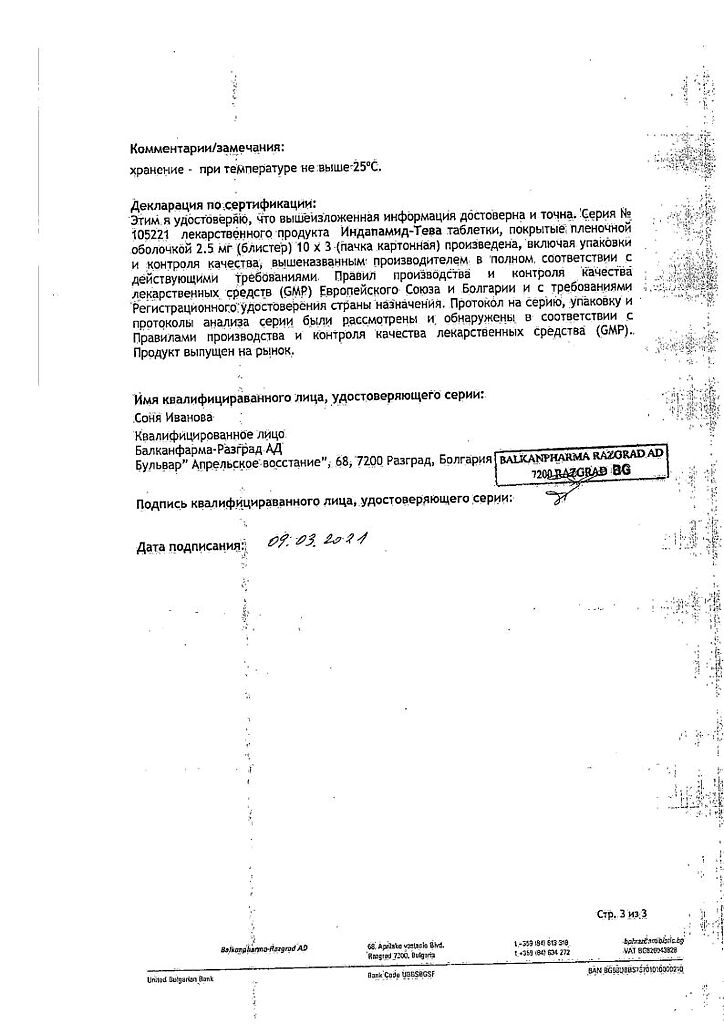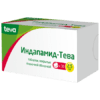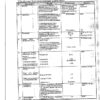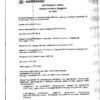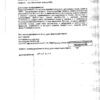No products in the cart.
Indapamide-Teva, 2.5mg 30 pcs
€3.09 €2.58
Description
Hypotensive agent, thiazide-like diuretic of moderate potency and long duration of action, benzamide derivative. It has moderate saluretic and diuretic effects associated with blockade of reabsorption of sodium, chloride, hydrogen and, to a lesser extent, potassium ions in proximal tubules and cortical segment of distal tubule of nephron.
The vasodilatory effects and reduction of total peripheral vascular resistance have the following mechanisms at their core: reduction of vascular wall reactivity to noradrenaline and angiotensin II; increased synthesis of prostaglandins with vasodilatory activity; inhibition of calcium flow in vascular smooth muscle walls.
Limits the tone of arterial smooth muscle, reduces total peripheral vascular resistance. Helps reduce left ventricular hypertrophy. In therapeutic doses does not affect lipid and carbohydrate metabolism (including patients with concomitant diabetes).
The antihypertensive effect developed at the end of the first/beginning of the second week with continuous use and maintained for 24 hours after single use.
Indications
Indications
Arterial hypertension.
Active ingredient
Active ingredient
Composition
Composition
1 tablet contains:
The active ingredient:
indapamide hemihydrate 2.5 mg;
Associates:
Lactose monohydrate 63.5 mg,
Corn starch 20.0 mg,
Povidone 7.0 mg,
calcium phosphate dihydrate 3.0 mg,
magnesium stearate 1.5 mg,
talc 2.5 mg;
film coating:
Opadry (Opadry® OY-B-28920) 2.5 mg (polyvinyl alcohol, titanium dioxide (E 171), talc, soy lecithin, xanthan gum).
.
How to take, the dosage
How to take, the dosage
Overly, preferably in the morning, regardless of meals, 2.5 mg (1 tablet) per day with plenty of fluid.
Maximum daily dose is 1 tablet.
Interaction
Interaction
Saluretics, cardiac glycosides, gluco- and mineralocorticoids, tetracosactide, amphotericin B (IV), laxatives increase the risk of hypokalemia.
Concomitant administration with cardiac glycosides increases the risk of digitalis intoxication; with Ca 2+ preparations – hypercalcemia; with metformin – possible aggravation of lactic acidosis. Increases the concentration of Li + ions in blood plasma (decreased urinary excretion), lithium has nephrotoxic effect.
Astemizole, erythromycin w/v, pentamidine, sultopride, terfenadine, vincamine, class Ia antiarrhythmic drugs (quinidine, disopyramide) and class III (amiodarone, bretilium, sotalol) may lead to the development of arrhythmias such as “torsades de pointes”.
Non-steroidal anti-inflammatory drugs, glucocorticosteroids, tetracosactide, sympathomimetics decrease the hypotensive effect, baclofen increases it.
Combination with potassium-saving diuretics may be effective in some patients; however, the possibility of hypo- or hyperkalemia is not completely excluded, especially in patients with diabetes and renal insufficiency.
Angiotensin-converting enzyme inhibitors increase the risk of arterial hypotension and/or acute renal failure (especially if there is renal artery stenosis).
Adds the risk of renal dysfunction when using iodine-containing contrast agents in high doses (dehydration of the body).
Patients should restore fluid loss before using iodine-containing contrast agents.
Imipramine (tricyclic) antidepressants and antipsychotics increase the hypotensive effect and increase the risk of orthostatic hypotension. Cyclosporine increases the risk of hypercreatininemia.
Limits the effect of indirect anticoagulants (coumarin or indandion derivatives) due to the increased concentration of clotting factors as a result of decreased circulating blood volume and increased production by the liver (dose adjustment may be required).
It increases the blockade of neuromuscular transmission that develops under the action of nondepolarizing myorelaxants.
Special Instructions
Special Instructions
In patients taking cardiac glycosides, laxatives, against a background of hyperaldosteronism, as well as in elderly patients, regular monitoring of K + ions and creatinine is indicated.
When taking indapamide the concentration of K +, Na +, Mg 2+ ions in blood plasma should be monitored regularly (electrolyte disorders may develop), pH, concentration of glucose, uric acid and residual nitrogen.
The most careful control is indicated in patients with liver cirrhosis (especially with edema or ascites – risk of metabolic alkalosis, intensifying manifestations of hepatic encephalopathy), coronary heart disease, heart failure and in elderly persons.
Patients with prolonged QT interval on electrocardiogram (congenital or developed against the background of some pathological process) also belong to the high-risk group.
The first measurement of blood K + concentration should be done in the first week of treatment.
Hypercalcemia on Indapamide administration may be due to previously undiagnosed hyperparathyroidism.
In patients with diabetes it is extremely important to control blood glucose levels, especially in the presence of hypokalemia.
Significant dehydration may lead to acute renal failure (decreased glomerular filtration). The patients must compensate for the loss of water and carefully monitor renal function at the beginning of treatment.
Indapamide may give a positive result in doping control.
Patients with arterial hypertension and hyponatremia (due to diuretics) should stop diuretics 3 days before starting angiotensin-converting enzyme inhibitors (if necessary diuretics can be restarted later), or they are prescribed initial low doses of angiotensin-converting enzyme inhibitors.
Sulfonamide derivatives may exacerbate systemic lupus erythematosus (should be kept in mind when prescribing indapamide).
Pediatric use: efficacy and safety in children has not been established.
Contraindications
Contraindications
Hypersensitivity to indapamide, other sulfonamide derivatives or other drug components, decompensated renal function (anuria) and/or liver (including with encephalopathy), hypokalemia, concomitant use of QT interval prolongers, pregnancy, lactation, age under 18 years (effectiveness and safety are not established).
Side effects
Side effects
Gastrointestinal tract: nausea/anorexia, dry mouth, gastralgia, vomiting, diarrhea, constipation are possible.
Nervous system disorders: asthenia, nervousness, headache, dizziness, somnolence, vertigo, insomnia, depression; rarely – increased fatigue, general weakness, malaise, muscle spasm, tension, irritability, anxiety.
Senses: conjunctivitis, visual impairment.
Respiratory system: cough, pharyngitis, sinusitis, rarely – rhinitis.
Cardiovascular system: orthostatic hypotension, electrocardiogram changes (hypokalemia), arrhythmia, palpitation.
Urinary system disorders: frequent infections, nycturia, polyuria.
Allergic reactions: rash, urticaria, pruritus, hemorrhagic vasculitis.
Laboratory measures: hyperuricemia, hyperglycemia, hypokalemia, hypochloremia, hyponatremia, hypercalcemia, increase in plasma urea nitrogen, hypercreatininemia, glucosuria.
Others: flu-like syndrome, chest pain, back pain, infections, decreased potency, decreased libido, rhinorrhea, sweating, weight loss, tingling in extremities, pancreatitis, exacerbation of systemic lupus erythematosus.
Overdose
Overdose
Symptoms: nausea, vomiting, weakness, gastrointestinal dysfunction, water-electrolyte disorders, in some cases – excessive reduction of blood pressure, respiratory depression. In patients with liver cirrhosis a hepatic coma may develop.
Treatment: gastric lavage, correction of water-electrolyte balance, symptomatic therapy. There is no specific antidote.
Similarities
Similarities
Additional information
| Shelf life | 5 years |
|---|---|
| Conditions of storage | Store in a dry, light-protected place at a temperature not exceeding 25°C. |
| Manufacturer | Balkanpharma – Troyan AD, Bulgaria |
| Medication form | pills |
| Brand | Balkanpharma – Troyan AD |
Related products
Buy Indapamide-Teva, 2.5mg 30 pcs with delivery to USA, UK, Europe and over 120 other countries.

